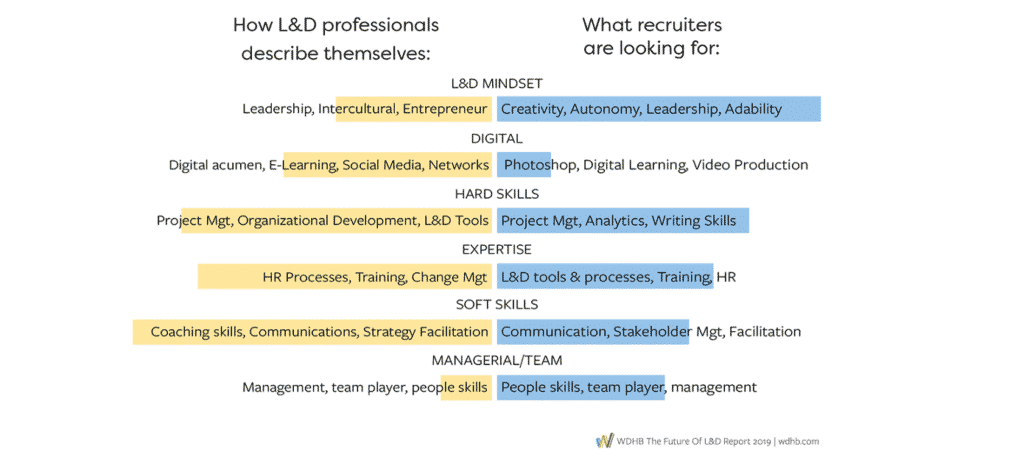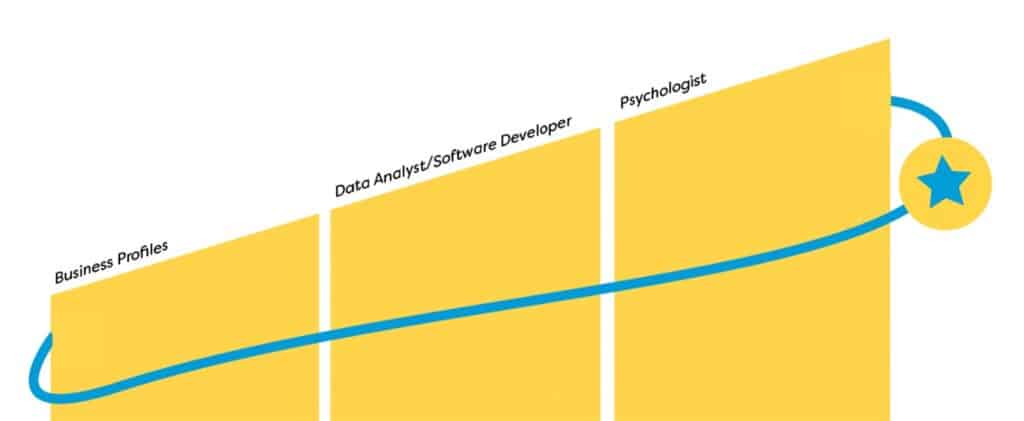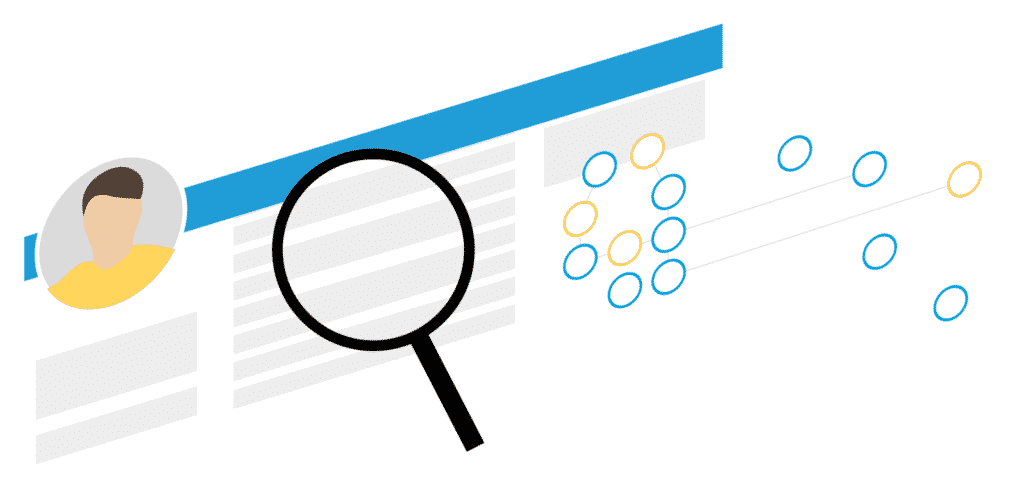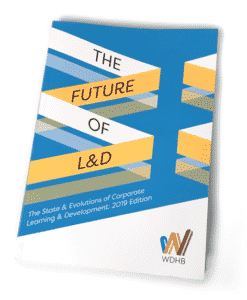How to Future Proof your L&D Team

Learning & Development profiles today are at a crossroads between people-centric and data-centric profiles. A research project with leading L&D leaders revealed what the ideal mix is for their teams to succeed in the future.
As the L&D function evolves, how do their roles also change? Are they well equipped and competent to tackle these new responsibilities?To answer these questions, we interviewed leading L&D experts and practitioners. But taking it a step further, we also conducted an in-depth online study analyzing L&D job-offers as well as LinkedIn profiles to better understand what companies are looking for in new hires, and what experienced practitioners feel the L&D role represents to them.
Our goal was to build a vision of what sort of L&D team would be best suited to thrive in these new horizons.
Many statements show how important it is for any L&D practitioner to know the ins and outs of their organization.
“What is most important for me is the knowledge of the organization and its ecosystem”, said Dominique Pépin from Saint Gobain.
Janin Schwartau from thyssenkrupp adds: “In my team, the only HR expert is leading our HR Campus. Members of the team come from business and consulting, and share a strong interest in learning. I believe this could be one of our key success factors, gaining us a wide acceptance in the business.”
On the other hand, their digital ability also appears to be a strong requirement: to easily navigate in their own organizations, L&D professionals should “possess digital skills and knowledge of digital learning processes”.
Are You Selling What They’re Buying?
The small study conducted on the L&D job market helped us dig deeper. Through an analysis of 70 job offers for L&D profiles on LinkedIn, Monster, Météojob and Welcome to the Jungle, we’ve synthesized the verbatim used by professional recruiters to describe the ideal profile of the L&D candidates they are looking to hire.
Among the top 10 most used descriptors in job ads, half come from the mindset and soft skills analysis categories, such as proactivity and creativity. Together they also account for 50% of the descriptors used in job ads to describe what companies expect in their ideal L&D profile.

However, this does not prevent companies from expecting their L&D practitioners to be able to measure their contribution and impact. Indeed, within the hard skills category, the most cited terms are “Project Management” and “Analytics,” which reflect the need to for L&D people to be both capable of leading projects from A to Z, and to use data-based analysis to report on their progress.
Interestingly, during our discussions, several of the interviewees admitted to challenging the very idea of recruiting people with an HR background for their L&D teams.
Analyzing 70 L&D profiles on LinkedIn using verbatim coding analysis, we discovered that L&D professionals perceive themselves as much more digital-savvy (Digital Acumen ranks in the top 10 most used descriptors) than the job offers studied previously would suggest, which highlights the progress that recruiters must make at this level.
New Teams to Meet New Expectations
We believe that L&D people are no longer just content providers and/or simple program managers, but must take a new place in the organization, as engineers of a learning ecosystem. This ecosystem and its sustainability, as well as their responsibilities for the development of people, turn them into change drivers, while requiring them to make a significant effort in terms of accountability. These changes in the function, therefore, call into question traditional L&D competencies and require companies to think carefully about the skilling of L&D teams.
Talking to Daniel Vonier from SAP, we understood that having diverse profiles in L&D teams is essential, and while there is no secret recipe, Daniel feels that “A great mix would be based upon three pillars: people with a data analyst or UX development background, people with psychology and behavior knowledge, and finally people coming from the business.”

The Magic 3
We believe that these 3 pillars can help in building a highly efficient L&D team, and to do so, they should be understood as follows:
- Business Profile: People coming from the business have a better understanding of the business needs and how to translate them into L&D policies. They know how to talk to leaders, understand their technical language and sub-cultures within the organization, as well as how to meet their expectations.
- Data Analyst/Software Developer: Data Analyst/ Developer profiles bring their expertise on data analysis, supporting the L&D function’s accountability in the company by allowing its performance and impacts to be managed through data crunching and analysis. UX developers and related backgrounds contribute their focus on User Experience (UE) and User-friendly platforms, enabling them to come up with ideas and methods to enhance learners’ experience (LX). David Hindley, former HRD for Danone and Disney supports this notion: “An L&D function with great standards on EX (employee experience) is very rare on the market, even if it is an important part of its impacts. It is very needed.”
- Psychologist: Psychologists profiles or people with social sciences backgrounds bring their understanding of human behaviors and learning processes at the individual scale, and they know what triggers to leverage to enhance the learning curves and knowledge acquisition for individuals. Complemented with coaching expertise, these profiles can provide learning frameworks and co-development processes fitting the learner’s culture, mindset, and behaviors in the organization. An important part of their responsibilities is to ensure that their L&D team’s content is pedagogically sound and reliable as they are also supporting people development and bridging individual goals with those of the organization.
New Roles are Emerging
We are foreseeing new types of positions within the L&D function in the near future. For example, the emphasis on the employee’s experience in a learning situation, combined with the recruitment of a profile with a background in UX development, could lead to Employee Learning Experience Designer: they interpret the knowledge to be acquired into enhanced learning experiences. They perfectly know the various learning processes and which platforms (digital or offline) to use to optimize learning, and can even design these themselves.
The Data Analyst/Performance Consultant job will also emerge within the L&D function. Such a profile must have the dual ability to analyze business intelligence data and L&D data and then combine these analyses to report on the impacts of the L&D function’s activities to business leaders.
Becoming the architects of a system that promotes the learning mindset also implies that management will be necessary to make it sustainable. With this in mind, the function of Community Engagement Manager will ensure that L&D takes responsibility for ensuring the sustainability of the learning community formed within the organization. They can make sure that there is a constant drumbeat of content, communications, new learning experiences, etc., and would continuously manage employees’ engagement in learning.
These new jobs do not imply that more traditional roles will disappear, but simply that they will evolve. To satisfy these evolutionary needs, organizations must allow themselves to develop and acquire the L&D mindset presented above. Thus, competencies in organizational development, change management, systemic thinking and digital upskilling will be vital to building a thriving learning ecosystem.

Are HR and Learning Moving Apart?
The L&D function, and in particular its professionals, are at a crossroads. Traditionally, the HR function supplied a dominant proportion of the people working in L&D, but this trend has shifted towards diversification, and new profiles appear that embody the L&D function’s refreshed identity.
To meet its newfound positioning as an architect of an internal Learning Hub, a learning mindset leader, and a change driver, L&D must arm itself with profiles in data analysis, UX/EX, development and learning psychology, to name a few. Digital remains an area in which companies must improve their efforts, both in the recruiting and in the training of their L&D practitioners. Finally, so many upheavals require further strategic and in-depth reflection on the development of L&D practitioners’ skills.
People working in L&D are turning into architects of an internal Learning Hub, a data-centric approach helps them bring accountability to the function.
The importance of labels such as “Talent Development” (top 8 of the most mentioned) and “Coaching” (top 9 of the most mentioned) also shows a new view that L&D people have of themselves: they are intrinsically agents of others’ development. Beyond their role as “program managers” and “learning system architects,” they are able to personally offer employees coaching and development sessions, thanks to their own skills in this field.

Get the full free L&D Report
This Article is an excerpt from “The Future of L&D” — A Report about the State and Evolutions of Corporate Learning & Development: 2019 Edition
Author
Subscribe to get Access to Exclusive Content





